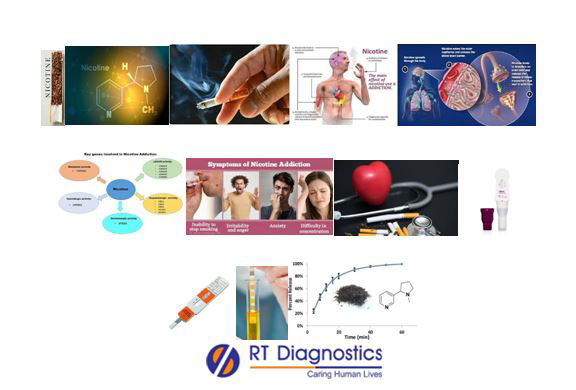Nicotine:
Why Nicotine Test?
CLINICAL INFORMATION
Nicotine is one of the chemical substances present predominantly in tobacco and its related products (eg. cigarettes). Initially, nicotine was used as an insecticide in the form of tobacco extracts (neonicotinoids example – imidacloprid) and in animal husbandries as a veterinary pesticide. Nicotine is a naturally produced alkaloid in the nightshade family of plants and in the family Solanaceae. Traces of nicotine are also found in certain vegetables. Nicotine is a stimulant drug (the recreational drug that is highly addictive due to the presence of monoamine oxidase inhibitors) that triggers to activate (the psychoactive ingredient) in the brain and also has a depressant action on the brain –CNS (Central Nervous System). Chewing tobacco (ingested) or smoking a cigarette (inhalation), leads to exposure to nicotine in the bloodstream. Nicotine is catabolized to cotinine, anabasine, nor-nicotine and 20 other compounds (metabolites eg. tobacco alkaloids) in the body by the liver. These substances are eliminated through the kidneys as urine. Hence this nicotine and its related compounds (eg. cotinine, nor-nicotine, anabasine etc) can be detected in the sample specimens such as blood, urine, saliva, nail, hair etc. Nicotine acts as a nervous stimulant and also has anxiolytic properties. Nicotine acts as a receptor agonist at most nicotinic acetylcholine receptors (nAChRs). Nicotine increases cholinergic and adrenergic signalling (nicotine increases dopamine levels which improves mood and increases the feeling of pleasure etc). Thus nicotine first causes the release of the hormone epinephrine which further stimulates the CNS and thus it prompts to trigger drug-induced feelings of pleasure (due to increased levels of dopamine in the body) and over time leads to habit due to its craving (addiction). Clinical manifestations include an increase in blood pressure, heart rate, narrowing of arteries, hardening of arteries, heart attack etc. Nicotine in short term causes bad breath and a reduction in senses like taste and smell etc. Chronic use of nicotine can cause COPD, respiratory infections, stroke, hypersensitivity to nicotine, leads to permanent brain damage, causes genotoxicity, and can create physical or psychological dependence, hence leading to distress. At high doses, nicotine can cause hypersensitivity to nicotine and can cause nicotine poisoning (salivation, bradyarrythmia, formation of blood clots, possible seizures, hypoventilation and death). Signs of adverse effects include headache, light-headedness, dizziness, nausea, vomiting, gastrointestinal symptoms, abdominal cramps, drooling, burning sensation in the mouth, sleep disorders, palpitations, paralysis, oral/nasal reactions, hiccups, cancers (since it impedes apoptosis, promotes tumour growth, activates growth factors and cellular mitogenic factors such as EGF, lipo-oxygenase etc). Constant use of nicotine in the body develops strong withdrawal symptoms in most cases of smoking cessation (quitting smoking). Hence nicotine is also used primarily for therapeutic use (nicotine replacement products like e-cigarettes to minimize addictiveness like intense tobacco craving etc) to treat nicotine dependence and also is used in pathologies associated with Parkinson’s disease, dementia, ADHD, depression, sarcoma etc. Thus controlled level of nicotine is given to patients through chewing gums, dermal patches, lozenges, inhalers or nasal sprays etc. In pregnancy, nicotine has a teratogenic effect and can lead to low birth weight babies. In children it interferes with parts of brain development thus it obstructs attention, learning, and impulse control and results in mood swings. Lungs, nicotine causes inflammation in the lungs. Laboratory examination for the presence of nicotine in patients is called a nicotine test. A nicotine test is performed in both blood and urine (cotinine) sample specimens. These tests include qualitative and qualitative analysis. These tests are performed in cases that include surgeries, medical testing, prospective employment assessment (hiring firms can legally deny a job due to nicotine habits), insurance medical exam, smoking cessation programs (rejuvenation centres), suspicion of nicotine overdose etc. Nicotine is found to interfere with many medications causing drug-nicotine interactions and hence also affects the lab test results (during medications). False-positive results are common with blood testing due to the presence of similar analogues (i.e thiocyanate) found in foods like broccoli, garlic, cabbage etc and in certain medications. Additional tests include Liquid Chromatography-Tandem Mass Spectroscopy – LC-MS/MS). Other tests include CBC, imaging studies etc.

General Instructions:
Sample Requirement: Specimen - Blood sample collected from the vein or urine (as suggested by the Doctor). Test Preparation: None.
NOTE - Sample for specimen collections may vary based on the patient’s condition/cases according to the patient’s presenting complaints/signs or symptoms:
SPECIMEN REQUIREMENT (Special or Rare Cases) - As instructed and guided by Physician / Clinician / Pathologist / as per Laboratory’s requirements, according to procedures and protocols.
This Multi-Specialty Clinical Referral Laboratory RT DIAGNOSTICS provides precise and accurate tests with an extensive range of testing services to the medical centres to help in the diagnosis and identification of pathology in the test specimens for infectious diseases and also to evaluate the function of organ systems of the patient. It prevents further complications and helps to stabilize and restore health to near normalcy at the earliest without delay.



